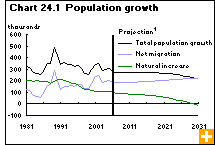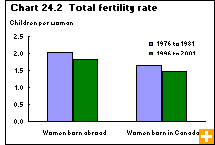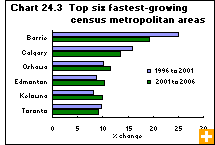Common menu bar links
Population
Archived Content
Information identified as archived is provided for reference, research or recordkeeping purposes. It is not subject to the Government of Canada Web Standards and has not been altered or updated since it was archived. Please contact us to request a format other than those available.
Canada’s population grew slightly over the past few years, despite an aging population and low fertility among women. On July 1, 2006, it reached the 32.6 million mark.
In large part, Canada depends on immigration for its population growth. From July 2005 to June 2006, two-thirds of the country’s population increase was due to immigration, as Canada welcomed 254,400 immigrants. That’s slightly above the annual average of 225,000 since the early 1990s. At the same time, the natural increase—births minus deaths—continued to drop. The most recent estimates show a drop from 210,500 people in 1990/1991 to 108,600 in 2005/2006.
Most of the Canadian population lives in a narrow corridor at the southern part of the country, near the American border. On July 1, 2006, 62% of the population lived in Quebec and Ontario, the two largest provinces.
The vast polar expanses of the Northwest Territories, Yukon and Nunavut represent 40% of the continental mass of Canada and are much less populated. Their inhabitants make up just 0.3% of the population.
Lower fertility
Many Canadian couples wait to start a family, mainly because they are completing their studies and marrying in their late twenties. The average age of women who gave birth in 2004 was 29.7 years, a slight increase compared with 29.6 years in 2003. This continues a 30-year trend toward having children later in life.
By delaying pregnancy, couples often have fewer children. Over the past two decades, fertility among Canadian women has generally declined. The total fertility rate was 1.49 children per woman in 2000, down from 1.65 in 1981. Since then, it has risen slightly to 1.53 in 2003 and 2004.
Canada’s total fertility rate is similar to that of other industrialized countries, but lower than that of the United States, where the rate for many years has been very close to the replacement level of 2.1 children per woman. U.S. population growth depends more on natural increase than in Canada, where two-thirds of our growth is due to immigration.
According to the 2001 Census, the total fertility rate of immigrants who came to Canada from 1996 to 2001 was 3.1 children per woman, higher than that of other Canadian women. However, the longer an immigrant woman resides in Canada, the more closely her fertility resembles that of other Canadian women.
Our population is aging quickly
Although Canada has one of the highest life expectancies of industrialized countries, the number of deaths has continued to rise since the beginning of the decade, due to an increasing and aging population. In 2005/2006, 234,914 people died in Canada, up from 219,114 deaths recorded in 2000/2001.
While life expectancy is increasing and fertility remains relatively stable, the population is aging quickly. On July 1, 2006, the median age of the Canadian population was 39 years, up from 31 years in 1985.
The elderly represented 13% of the population, almost twice the proportion of 7% at the start of the baby boom in 1946. Over the same period, the proportion of people aged 20 to 64 rose from 56% to 63%.
At the same time, the proportion of children and young people fell considerably. On July 1, 2006, the group aged 19 and younger represented 24% of the population, versus 37% in 1946. This trend is expected to continue over the next 50 years.
Since men do not tend to live as long as women, there are fewer men in older age groups. In 2005/2006, there were 91 men for every 100 women in the 65-to-74 age group. In the 90-and-over group, the ratio was 36 men for every 100 women. However, in the 19-and-under population, there were 105 boys for every 100 girls.
Unequal growth
In 2005/2006, only three provinces and one territory experienced higher population growth than the 10.0 people per 1,000 inhabitants recorded in Canada as a whole: Alberta (29.5 per 1,000), British Columbia (12.3 per 1,000), Ontario (10.2 per 1,000) and Nunavut (24.4 per 1,000).
For the fourteenth consecutive year, Newfoundland and Labrador saw its population fall in 2005/2006, resulting in a negative growth rate (-8.4 per 1,000). The growth rates of the other provinces ranged from -4.6 people per 1,000 inhabitants in Saskatchewan to 7.1 per 1,000 in Quebec.
Migration fuels growth
Alberta, the province that has experienced the greatest population growth since 1997, owes this growth to a combination of relatively high natural increase compared with the other provinces, and a considerable increase in interprovincial migration and, to a lesser extent, international migration.
Like most Canadian provinces, the population growth of Ontario and British Columbia depends largely on immigration, whereas the population growth of Nunavut is due primarily to a total fertility rate of three children per woman, around twice that of the national rate. Meanwhile, from July 2005 to June 2006, Newfoundland and Labrador was the first province where it was estimated that deaths exceeded births in the course of one year.
Most Canadians continue to live in urban areas. According to the 2006 Census, 25.6 million people, more than 80% of Canada’s population, live in cities and the majority, 21.5 million people, live in one of our 33 census metropolitan areas (CMAs).
Six CMAs have a population of more than one million people—Toronto, Montréal, Vancouver and Ottawa–Gatineau and, for the first time, Calgary and Edmonton. Combined, these six urban areas are home to 14.1 million people, or 45% of the population.
Collectively, Canada’s CMAs grew at a faster rate than the national average. From 2001 to 2006, the six largest gained 6.9%; the rest of the country grew 5.4%. Fifteen CMAs had a higher rate of population growth than the national average. Of these, six are in Southern Ontario’s Greater Golden Horseshoe region—Barrie, Oshawa, Toronto, Kitchener, Guelph and Brantford.
The fastest growing CMA in 2006 was Barrie, which grew 19% to 177,061. It was followed by Calgary, which gained 13% to 1.1 million. From 2001 to 2006, the population of Canada’s small towns and rural areas rose 1%. The 2006 Census reported that just under 20% of Canadians, about 6 million people, live in small towns and rural areas.





